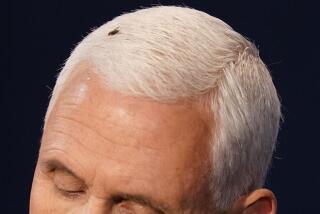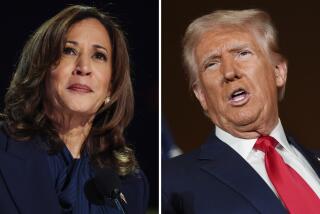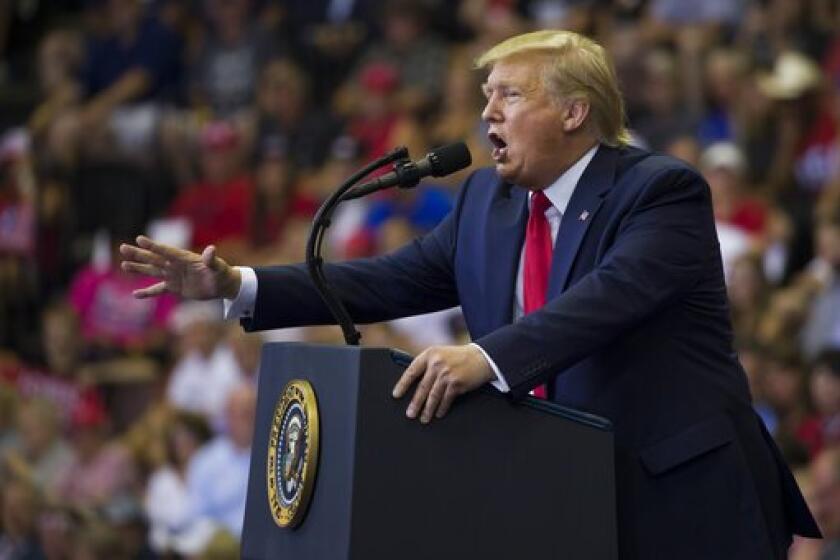You Can Rule Out Spontaneity in the Debates
- Share via
Voters tuning in to the first 2004 presidential debate Thursday may be expecting a freewheeling give-and-take between the candidates, but the occasion will actually be one of the most carefully structured events of the campaign.
The rules for the three presidential debates were negotiated between representatives of Sen. John F. Kerry and President Bush in a 32-page memorandum of understanding, and they leave little room for spontaneity.
They specify, among other things, that the candidates cannot pose questions directly to each other and that the moderators must use specific language when cutting off long-winded answers.
The two campaigns haggled over the temperature of the room, how far the men could wander from their lecterns and how a colored light would alert them if they went over their allotted time. The candidates can bring paper and pens or pencils, but all of the items must be submitted ahead of time so they can be placed on the lecterns, each of which will be constructed and placed to Kerry-Bush specifications.
Though past campaigns have made similar agreements, the 2004 debate rules between Kerry and Bush are the most detailed and far-reaching of any election, and have rankled political observers who say the candidates are attempting to control media coverage.
Under the agreement, which also covers the Oct. 5 vice presidential debate, television cameras cannot show one candidate while the other is speaking or broadcast images of the audience’s response -- prohibitions that the networks have rejected.
Political experts said the campaigns’ micro-management of the debates undermined their value.
“This is a parody of what real civic give-and-take is and could be in America,” said Martin Kaplan, director of USC’s Norman Lear Center, which studies the intersection of politics and entertainment.
“What we’re desperate for is some really serious discussion, beyond the sound bites, about the problems the country is facing,” he said. “Instead, what we’ve guaranteed is an exchange of bumper sticker slogans.”
The nonpartisan Commission on Presidential Debates, which sponsors and produces the events, has not signed the agreement, as requested by the Kerry and Bush campaigns. But in a statement posted on its website Monday, the commission said it would enforce the guidelines and not depart from them without the approval of the campaigns.
The campaigns are insisting that the moderators also sign the agreement or risk being replaced. ABC said Charles Gibson, who is to moderate the second debate, on Oct. 8 in St. Louis, would not do so.
Whether Jim Lehrer of PBS, who is to moderate the first debate -- in Coral Gables, Fla., on Thursday -- and the two other moderators will go along with the campaigns’ demands is unclear.
Some networks indicated they did not think they would.
The carefully crafted rules are part of a larger effort by the campaigns to control the image and impressions of each candidate, as well as to cut down on the element of surprise.
“It basically is ensuring that there will be a healthy exchange of ideas, there’ll be a lot of topics covered.... No gimmicks, no tricks, no sudden surprises, so that we really can have a debate that’s dominated by the issues,” Bush senior advisor Karen Hughes told ABC News Radio on Tuesday.
Both sides brought in political heavyweights to lead the negotiations: powerhouse Washington attorney Vernon Jordan for Kerry and former Secretary of State James A. Baker III for Bush.
“They’re trying to take into account all the contingencies,” said Zachary White, assistant professor of communication studies at the University of San Francisco. “They don’t want anything to be left to chance so the voters will fill in the gaps themselves.”
The lecterns will be 10 feet apart -- enough distance so the president’s shorter stature will not be in strong contrast to that of his lanky rival. And “no candidate shall be permitted to use risers or any other device to create an impression of elevated height,” according to the memorandum.
One issue that is somewhat unresolved: the temperature in the room. The Bush campaign wanted it above 70 degrees, hoping to get Kerry to break out in a sweat, while the Democrats were pushing for a cooler ambience. In the end, they settled on “industry standard.”
The most controversial provision in the memo attempts to prevent the TV networks from broadcasting the reaction of either candidate as the other is speaking. Those familiar with the negotiations said the president’s reelection team wanted the stipulation, which Bush also insisted on during his 1994 debate with then-Texas Gov. Ann Richards.
The networks have balked at such restrictions and refused to comply.
“We are not subject to agreements between the candidates,” said Barbara Levin, a spokeswoman for NBC News. “We will use pictures as we see fit.”
Media experts said the requirement infringes on journalistic freedom.
“Sometimes the expression of opinion or the reaction to differences is an essential piece of the story,” said Bob Steele, a senior member of the ethics faculty at the Poynter Institute. “To restrict video or still images of one candidate reacting to what the other has to say is exceptionally problematic.”
The Kerry campaign declined to comment on the attempted regulation, but Bush aides defended the move.
“I don’t think there’s any desire for anyone to control content in any way,” deputy campaign manager Mark Wallace said.
“The consensus of the campaigns is that it’s important that the productions focus on what’s important to the American people ... and the American people want to know what the candidates are saying.”
Most of the rules agreed upon by the campaigns govern the candidates’ behavior.
The rules include a ban on props of any kind, including charts, diagrams or “other tangible things.”
The candidates cannot refer to anyone in the audience, as Al Gore did in a 2000 debate with former New Jersey Sen. Bill Bradley, when he pointed out an Iowa farmer who had lost most of his crops in flooding, then asked his opponent why he had voted against the flood relief bill that year.
The former vice president also apparently inspired another regulation when, in a 2000 debate with Bush, he walked toward his rival while making a point. This year, the candidates must limit their movements to a “predesignated” area determined by the commission. The level of detail has made historians wistful for the days when the verbal jousting between candidates took a freer form.
Wayne Fields, a professor at Washington University in St. Louis who has written extensively on political rhetoric, noted that in the famed Lincoln-Douglas debates of 1858, one candidate spoke for an hour, the other rebutted for 90 minutes, and the first one had another 30 minutes to respond.
He described the upcoming Bush-Kerry sessions as “speeches coordinated so that they take place at the same time, planned by handlers in such a way the candidates will be influenced as little as possible by the other one’s presence.”
*
Times staff writer Mark Z. Barabak contributed to this report.
*
(BEGIN TEXT OF INFOBOX)
The no-no’s
According to a 32-page memorandum of understanding signed by the campaigns of Sen. John F. Kerry and President Bush, neither candidate may:
* Use charts, diagrams or “other tangible things.”
* Make references to members of the audience.
* Ask each other direct questions (although rhetorical questions are permitted).
* Leave their “predesignated” area onstage.
* Address each other with proposed pledges on policy or campaign tactics.
Source: Times staff
Los Angeles Times
More to Read
Get the L.A. Times Politics newsletter
Deeply reported insights into legislation, politics and policy from Sacramento, Washington and beyond. In your inbox twice per week.
You may occasionally receive promotional content from the Los Angeles Times.










